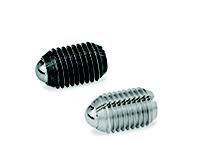Top Spring Plunger Uses and Benefits: Complete Guide

When it comes to precision engineering and mechanical assembly, small components often make a big difference. One such essential component is the spring plunger. Despite its simple design, the spring plunger plays a crucial role in various industrial and manufacturing applications. This article explores what a spring plunger is, its common uses, types, and the benefits it offers to different industries.
What Is a Spring Plunger?
A spring plunger is a mechanical device that combines a threaded body with a spring-loaded pin or ball. The main function of this component is to apply pressure or maintain position through its spring tension. It allows for controlled movement, positioning, indexing, or locking of machine parts, fixtures, or assemblies.
Spring plungers are designed for easy installation and adjustment. They come in various sizes and materials to suit different operational environments, from light-duty office equipment to heavy-duty industrial machinery.
Common Uses of Spring Plunger
Spring plungers are highly versatile and widely used across multiple industries. Here are some of the most common applications:
1. Positioning and Indexing
One of the primary uses of a spring plunger is to position parts accurately within assemblies. For example, they are often used in jigs and fixtures to hold components in place during machining or assembly processes. The spring-loaded pin presses against the part, ensuring it stays securely in the correct position without slipping.
2. Detent Mechanism
Spring plungers serve as detents, providing a positive stop or tactile feedback in mechanical systems. This function is common in adjustable knobs, levers, or switches where a defined position or click is needed. The spring tension allows the plunger to hold components at set intervals or positions, enhancing precision and usability.
3. Locking and Securing
In applications where parts need to be temporarily locked or secured, spring plungers are ideal. They provide enough force to hold components together but can be easily disengaged when adjustment or removal is necessary. This makes them popular in quick-release mechanisms or adjustable assemblies.
4. Industrial Machinery
Many types of machinery rely on spring plungers for smooth operation. From conveyor systems to robotics, these components help maintain alignment, reduce wear, and prevent unintended movement. Their ability to withstand repeated stress and maintain consistent force makes them indispensable in industrial settings.
5. Consumer Products
Spring plungers are not just industrial components; they also appear in everyday products. For example, they are used in office furniture for height adjustment, in electronics for securing battery covers, and in automotive interiors for various control elements.
Types of Spring Plunger
There are several varieties of spring plungers designed for specific needs:
- Ball Plungers: Use a ball bearing at the tip to provide smooth contact and reduced wear on mating surfaces. Ideal for indexing and positioning.
- Pin Plungers: Feature a cylindrical pin for higher strength and precise engagement, suitable for locking applications.
- Stainless Steel Plungers: Made for corrosion resistance in harsh environments, such as marine or food processing industries.
- Plastic Plungers: Lightweight and non-corrosive, perfect for electronics or light-duty applications.
Benefits of Using Spring Plunger
Choosing a spring plunger for your mechanical needs offers several advantages:
1. Reliable Positioning
The consistent spring force ensures that components stay in place firmly but can be easily repositioned if needed. This reliability improves overall assembly accuracy and repeatability.
2. Easy Installation and Adjustment
Most spring plungers come with threaded bodies, making installation straightforward. Adjusting the tension or position is as simple as screwing or unscrewing the plunger, saving time during setup or maintenance.
3. Durability and Longevity
High-quality spring plungers are made from materials that resist wear and corrosion. Their simple design also means fewer failure points, leading to longer service life even under demanding conditions.
4. Versatility
Spring plungers are adaptable to many different applications, sizes, and materials. This versatility means they can be customized to meet specific industry standards or specialized uses.
5. Cost-Effective Solution
Compared to more complex mechanical locking or positioning systems, spring plungers offer an economical way to achieve precision and reliability without sacrificing performance.
How to Select the Right Spring Plunger
Selecting the appropriate spring plunger involves considering several factors:
- Material: Choose stainless steel for corrosion resistance, plastic for lightweight needs, or standard steel for general applications.
- Size and Thread Type: Ensure compatibility with the equipment or assembly. Threaded sizes vary, so matching the plunger to the mounting hole is critical.
- Load Capacity: Consider the force required to hold or lock components securely. Heavier loads need stronger springs or larger plungers.
- Operating Environment: Factors like temperature, exposure to chemicals, or moisture can influence the best choice of material and design.
- Type of Tip: Decide between ball or pin tips based on the nature of the contact surface and the desired movement.
Maintenance Tips for Spring Plungers
Proper maintenance can extend the life of a spring plunger significantly:
- Regularly clean the plunger and mating surfaces to avoid dirt and debris buildup.
- Lubricate moving parts when applicable, especially in high-friction environments.
- Inspect the spring tension and replace plungers showing signs of wear or loss of force.
- Avoid excessive force during installation to prevent thread damage.
Conclusion
Spring plungers are small but vital components in the world of mechanical engineering and manufacturing. Their ability to provide precise positioning, secure locking, and smooth operation makes them indispensable across many industries. Whether used in industrial machinery, consumer products, or assembly fixtures, spring plungers deliver reliable performance and ease of use.
Choosing the right spring plunger depends on understanding your specific application needs and operating conditions. By investing in quality components and following proper maintenance practices, you can ensure optimal functionality and durability for your equipment.
In summary, the spring plunger offers a simple yet effective solution to many mechanical challenges, making it a must-have element in your engineering toolkit.



